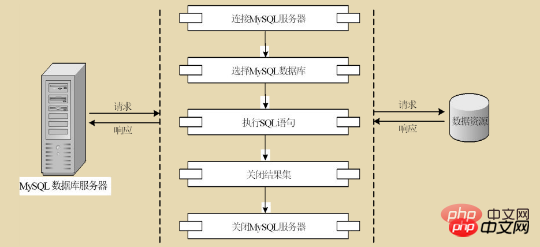php calls mysql steps
php steps to call mysql: 1. Connect to the MySQL database; 2. Select the MySQL database; 3. Execute the SQL statement; 4. Close the result set; 5. Close the MySQL server.

The operating environment of this article: windows7 system, PHP7.1 version, DELL G3 computer
Five steps for PHP to access MYSQL database Detailed explanation (picture)
Database is necessary in our daily development of PHP, so MYSQL database is a database that many programmers love, because MYSQL is an open source and a little bit commercial. It has a relatively high market share, so it has always been considered the best partner of PHP. At the same time, PHP also has strong database support capabilities. This article mainly explains the basic steps for PHP to access the MySQL database.
The basic steps for PHP to access the MySQL database are as shown in the figure:

1. Connect to the MySQL database
Use the mysql_connect() function to establish Connection to MySQL server. Regarding the use of the mysql_connect() function, we will introduce it in detail later.
2. Select the MySQL database
Use the mysql_select_db() function to select the database of the MySQL database server. And establish a connection with the database. Regarding the use of the mysql_select_db() function, we will have a detailed explanation later.
3. Execute SQL statements
Use the mysql_query() function to execute SQL statements in the selected database. There are mainly 5 ways to operate the data. We will introduce them separately below. Query data: Use the select statement to implement the data query function.
Display data: Use the select statement to display the query results of the data.
Insert data: Use the insert into statement to insert data into the database.
Update data: Use the update statement to update records in the database.
Delete data: Use the delete statement to delete records in the database!
The specific use of the mysql_query() function will be introduced in detail later~
4. Close the result set
After the database operation is completed, the result set needs to be closed to release system resources. The syntax format is as follows: mysql_free_result($result);
Tips:
If database access is required frequently on multiple web pages, you can establish a continuous connection with the database server to improve efficiency. Because each connection to the database server takes a long time and requires a lot of resource overhead, a continuous connection is relatively more efficient. The way to establish a continuous connection is to call the function mysql_pconnect() instead of the mysql_connect function when the database is indirect. The established persistent connection does not need to call mysql_colse() to close the connection with the database server at the end of this program. The next time the program executes the mysql_pconnect() function here, the system will automatically directly return the established persistent connection ID number without actually connecting to the database.
5. Close the MySQL server
If the mysql_connect() or mysql_query() function is not used once, system resources will be consumed. Even if a small number of users complete the web site, the problem will not be big, but if the user When the number of connections exceeds a certain number, system performance will decrease or even crash. In order to avoid this phenomenon, after completing the database operation, you should use the mysql_close() function to close the connection with the MYSQL server to save system resources.
The syntax format is as follows: mysql_close($link);
Explanation:
The connection to the database in PHP is a non-persistent connection, and the system will automatically recycle it. Generally, there is no need to set it to close. However, if the one-time Fanhu result set is relatively large, or the website visits are high, it is best to use the mysql_close() function to release it manually.
The steps for PHP to access the MySQL database are over. Isn’t it very simple?
Recommended learning: "PHP Video Tutorial"
The above is the detailed content of php calls mysql steps. For more information, please follow other related articles on the PHP Chinese website!

Hot AI Tools

Undresser.AI Undress
AI-powered app for creating realistic nude photos

AI Clothes Remover
Online AI tool for removing clothes from photos.

Undress AI Tool
Undress images for free

Clothoff.io
AI clothes remover

Video Face Swap
Swap faces in any video effortlessly with our completely free AI face swap tool!

Hot Article

Hot Tools

Notepad++7.3.1
Easy-to-use and free code editor

SublimeText3 Chinese version
Chinese version, very easy to use

Zend Studio 13.0.1
Powerful PHP integrated development environment

Dreamweaver CS6
Visual web development tools

SublimeText3 Mac version
God-level code editing software (SublimeText3)

Hot Topics
 1667
1667
 14
14
 1426
1426
 52
52
 1328
1328
 25
25
 1273
1273
 29
29
 1255
1255
 24
24
 MySQL: The Database, phpMyAdmin: The Management Interface
Apr 29, 2025 am 12:44 AM
MySQL: The Database, phpMyAdmin: The Management Interface
Apr 29, 2025 am 12:44 AM
MySQL and phpMyAdmin can be effectively managed through the following steps: 1. Create and delete database: Just click in phpMyAdmin to complete. 2. Manage tables: You can create tables, modify structures, and add indexes. 3. Data operation: Supports inserting, updating, deleting data and executing SQL queries. 4. Import and export data: Supports SQL, CSV, XML and other formats. 5. Optimization and monitoring: Use the OPTIMIZETABLE command to optimize tables and use query analyzers and monitoring tools to solve performance problems.
 Composer: Aiding PHP Development Through AI
Apr 29, 2025 am 12:27 AM
Composer: Aiding PHP Development Through AI
Apr 29, 2025 am 12:27 AM
AI can help optimize the use of Composer. Specific methods include: 1. Dependency management optimization: AI analyzes dependencies, recommends the best version combination, and reduces conflicts. 2. Automated code generation: AI generates composer.json files that conform to best practices. 3. Improve code quality: AI detects potential problems, provides optimization suggestions, and improves code quality. These methods are implemented through machine learning and natural language processing technologies to help developers improve efficiency and code quality.
 Steps to add and delete fields to MySQL tables
Apr 29, 2025 pm 04:15 PM
Steps to add and delete fields to MySQL tables
Apr 29, 2025 pm 04:15 PM
In MySQL, add fields using ALTERTABLEtable_nameADDCOLUMNnew_columnVARCHAR(255)AFTERexisting_column, delete fields using ALTERTABLEtable_nameDROPCOLUMNcolumn_to_drop. When adding fields, you need to specify a location to optimize query performance and data structure; before deleting fields, you need to confirm that the operation is irreversible; modifying table structure using online DDL, backup data, test environment, and low-load time periods is performance optimization and best practice.
 What is the significance of the session_start() function?
May 03, 2025 am 12:18 AM
What is the significance of the session_start() function?
May 03, 2025 am 12:18 AM
session_start()iscrucialinPHPformanagingusersessions.1)Itinitiatesanewsessionifnoneexists,2)resumesanexistingsession,and3)setsasessioncookieforcontinuityacrossrequests,enablingapplicationslikeuserauthenticationandpersonalizedcontent.
 How to uninstall MySQL and clean residual files
Apr 29, 2025 pm 04:03 PM
How to uninstall MySQL and clean residual files
Apr 29, 2025 pm 04:03 PM
To safely and thoroughly uninstall MySQL and clean all residual files, follow the following steps: 1. Stop MySQL service; 2. Uninstall MySQL packages; 3. Clean configuration files and data directories; 4. Verify that the uninstallation is thorough.
 An efficient way to batch insert data in MySQL
Apr 29, 2025 pm 04:18 PM
An efficient way to batch insert data in MySQL
Apr 29, 2025 pm 04:18 PM
Efficient methods for batch inserting data in MySQL include: 1. Using INSERTINTO...VALUES syntax, 2. Using LOADDATAINFILE command, 3. Using transaction processing, 4. Adjust batch size, 5. Disable indexing, 6. Using INSERTIGNORE or INSERT...ONDUPLICATEKEYUPDATE, these methods can significantly improve database operation efficiency.
 How to use MySQL functions for data processing and calculation
Apr 29, 2025 pm 04:21 PM
How to use MySQL functions for data processing and calculation
Apr 29, 2025 pm 04:21 PM
MySQL functions can be used for data processing and calculation. 1. Basic usage includes string processing, date calculation and mathematical operations. 2. Advanced usage involves combining multiple functions to implement complex operations. 3. Performance optimization requires avoiding the use of functions in the WHERE clause and using GROUPBY and temporary tables.
 Detailed explanation of the installation steps of MySQL on macOS system
Apr 29, 2025 pm 03:36 PM
Detailed explanation of the installation steps of MySQL on macOS system
Apr 29, 2025 pm 03:36 PM
Installing MySQL on macOS can be achieved through the following steps: 1. Install Homebrew, using the command /bin/bash-c"$(curl-fsSLhttps://raw.githubusercontent.com/Homebrew/install/HEAD/install.sh)". 2. Update Homebrew and use brewupdate. 3. Install MySQL and use brewinstallmysql. 4. Start MySQL service and use brewservicesstartmysql. After installation, you can use mysql-u




